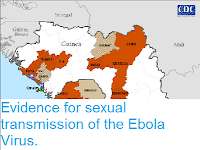The World Health Organisation has reported an outbreak of Ebola Hemorrhagic Fever in Equateur Province, Democratic Republic of Congo, after two people tested positive for the Virus which causes the disease this week. Eighteen people are reported to have died in the remote town of Bikoro on Lake Tumba, with another sixteen showing symptoms of the disease as of 11 May 2018. Teams from the World Health Organisation and Médecins Sans Frontières have been deployed to the region to provide assistance to local medical agencies, with an experimental vaccine against the disease developed since the 2014 West African Ebola outbreak being deployed for the first time in the hope of halting the spread of the disease.
Scientists at the Institut National de Recherche Biomédicale in Kinshasa, where blood samples collected from hemorrhagic fever victims in Eqateur Province, Democratic Republic of Congo, tested positive for the Ebola Virus this week. WHO.
Ebola Hemorrhagic Fever is caused by RNA Viruses of the genus Ebolavirus.
It has a reputation for being the world's deadliest viral disease, at
least in part due to the 1995 film Outbreak, though this is probably
slightly inaccurate as about 50% of victims survive, making it less
deadly than diseases such as Rabies. However it is extremely contagious,
with know known cure, and has a tendency to rapidly
overwhelm local health systems as health workers themselves are
infected.
Ebola begins with a fever similar to that caused by Influenza or
Malaria, which tends to come on rapidly two-to-three weeks after
infection (during at least part of which time the patient is already
infectious). This tends to be followed by extreme respiratory tract
infection, headaches, confusion, rashes and tissue necrosis and heavy
bleeding. Death is generally caused by multiple organ failure.
The only known treatment for Ebola is intensive rehydration, which can
improve the survival prospects of patients greatly, accompanied by
anticoagulants and procoagulants to mange the diseases attacks on the
circulatory system, analgesia to cope with the pain of the disease and
antibiotics and antimycotics to prevent secondary infection. Due to the
highly contagious nature of the disease it is recommended that
healthcare workers wear full-body protection to maintain a barrier
between them and their patients; a daunting prospect in the tropical
regions of Africa where the disease is endemic.
Ebolavirus is thought to have a non-human animal vector, since
its rapid onset and high mortality rate appears to preclude a permanent
residence within Human hosts. Surveys of wild animals have found Ebola
infections in Rodents and Great Apes, however these were affected by the
disease in a similar way to Humans, and are therefore unlikely
permanent hosts. The most likely vectors are thought to be Fruit Bats or
small Primates, which are endemic to the areas where the disease occurs
and which are widely eaten; cooking meat probably kills the virus, but
there is a distinct danger of infection while preparing carcasses.
Electron micrograph of an Ebola Virus particle. Frederick Murphy/Centers for Disease Control and Prevention/Wikimedia Commons.
See also...
Follow Sciency Thoughts on Facebook.






